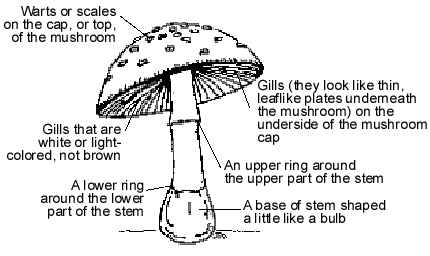Dr. MJ Bazos MD,
Patient Handout
Mushroom Poisoning in
Children
Is it possible to tell if a wild
mushroom is poisonous?
No. You can't tell for sure if a mushroom is
poisonous by looking at it, unless you are an expert at identifying mushrooms.
There are no tests to help you tell a poisonous mushroom from a nonpoisonous
mushroom.
Does it help to see how the wild
mushroom is growing?
Yes, a little. Mushrooms growing in the ground
are more dangerous than mushrooms growing on living trees. Mushrooms on the
ground in forests are usually more dangerous than mushrooms on lawns. The
characteristics shown below often indicate danger:
 Signs that a mushroom may be
poisonous
Signs that a mushroom may be
poisonousWhat are the symptoms of mushroom
poisoning?
Early symptoms of mushroom poisoning include
feeling sick, stomach cramps, vomiting and watery or bloody diarrhea. Symptoms
may show up right after your child eats the mushroom, or may appear several
hours later. If your child has any of these symptoms, call your doctor right
away. Your child may need treatment.
What should be done if my child eats
a wild mushroom?
Don't panic. There are thousands of kinds of
mushrooms in North America. Only about 100 can hurt humans. If your child has
eaten a wild mushroom, you can take several simple steps. Collect the mushrooms
your child was eating. A few should be carefully dug up so that even the
underground parts can be saved for identification. The whole mushroom can then
be shown to your child's doctor, which might help your doctor know whether the
mushroom was poisonous or not. If you find more than one kind of mushroom around
your child, collect all of the different kinds that your child might have eaten.
What should be done next?
Call your family doctor to see if your child can
be seen right away. If your doctor can't see your child right away, call the
emergency department at your local hospital. They will ask you questions about
your child and tell you what to do. Bring the mushrooms you collected to the
emergency room. You can also get help from your local poison control center.
Look up this number in your telephone book. It's a good idea to keep this number
by your telephone at all times.
Should syrup of ipecac be given to
children who may have eaten wild mushrooms?
Check with your child's doctor, the local poison
control center or the hospital emergency room. If your child is alert and has
not vomited, you might be told to give your child syrup of ipecac. First give
your child several glasses of water or clear juice to drink. Then give the
ipecac. Give 1 teaspoon to an infant, 1 tablespoon to children 1 to 12 years of
age, and 2 tablespoons to children over 12 years of age. Your child should throw
up everything in his or her stomach very soon after taking the ipecac. If he or
she hasn't vomited within 20 minutes, give the same ipecac dose again.
What will happen in the emergency
room?
If your child has thrown up, the worst is
probably over. If he or she has not thrown up, your child may be given ipecac or
activated charcoal in the emergency room. The physician will find a local
mushroom expert to talk to. Your child's temperature, heart rate and blood
pressure will be checked. He or she will be watched closely for signs of
mushroom poisoning. If your child has no symptoms of mushroom poisoning after
the ipecac has worn off, and if the mushroom is identified as harmless, you and
your child will probably be sent home. Your doctor will ask you to watch your
child for any symptoms of mushroom poisoning for the next 24 hours.

